Waldorf News
Totem pole at the HUB stands as a symbol of community: Sunrise Waldorf School hosted Scow and the totem pole for the winter until the raising
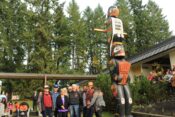
Sunrise Waldorf School hosted Scow and the totem pole for the winter until the raising
By Shalu Mehta
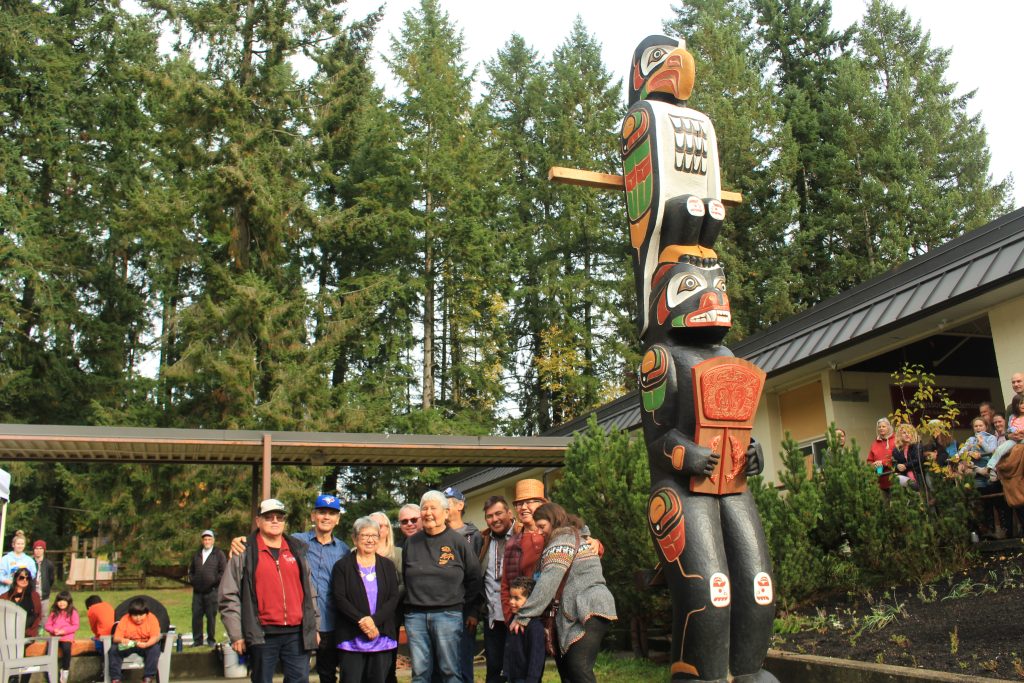
Rupert Scow (wearing the cedar hat) stands with his family next to the totem pole that he gifted to The Hub at Cowichan Station and the community. Photo by Shalu Mehta/The Discourse
A gathering at The HUB at Cowichan Station on Sunday brought community members together to celebrate the work of Kwakwa̱ka̱ʼwakw artist Rupert Scow and raise a totem pole that he — with the support of many others — built and gifted to the community.
Dozens of people of all ages and backgrounds arrived at the HUB on Sunday morning and eagerly waited outside to witness the raising of the totem pole. Forecasted rain held off during the gathering, and the sun made appearances throughout the day.
Children ran and played, periodically asking questions about the totem pole which was seen leaning backwards with ropes tied around it to help with the raising. Many adults in the crowd spoke fondly of Scow, who has been working on the totem pole at the HUB and nearby Sunrise Waldorf School for the past year.
The totem pole was a gift from Scow to the Cowichan Station Area Association and community, and represents community and coming together, Scow said. But the totem pole — and Scow’s journey — began long before they arrived at the HUB.
Scow is Kwikwasut’inuxw (the People of the Bear), part of the larger Kwakwa̱ka̱ʼwakw tribal grouping, from the village of Gwa’yasdams on Gilford Island near Alert Bay. He comes from a lineage of carvers, famous for the totem poles and articulated masks they carved.
His great grandfather is Chief John Scow and on his mother’s side, his great grandfather is Chief Mungo Martin, an acclaimed Kwakwa̱ka̱ʼwakw artist and master carver.
In his 30s, Scow began learning to carve with his brother, Leonard Scow, in their village’s workshop. They learned from many other skilled carvers, spending hours at a time carving, Scow said.
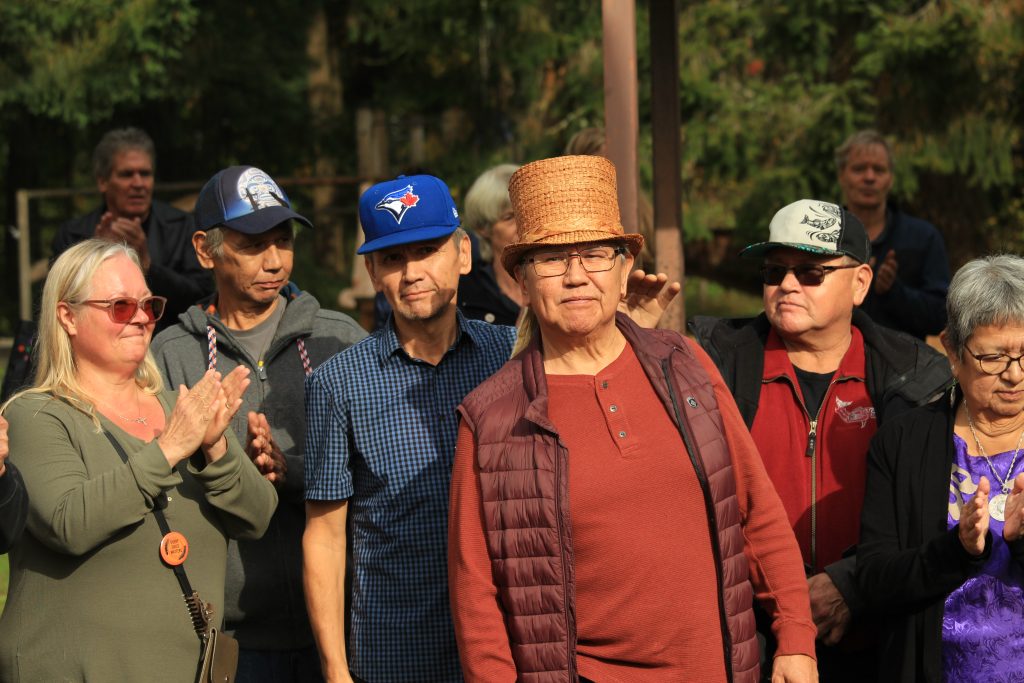
Rupert Scow (centre) stands, surrounded by family, at the totem pole raising at the HUB. Photo by Shalu Mehta/The Discourse
He began carving the totem pole that is now at the HUB in 2010 when he was in Roberts Creek on the Sunshine Coast, Scow said. The Western red cedar was gifted to him by a friend. He then moved to the Lower Mainland and continued to work on it, but suffered a stroke in 2016 and his carving was put on hold.
He was told by doctors that he may not be able to walk again, but with determination and support from friends, family and caregivers, Scow was able to re-learn carving. He first re-learned to carve with his non-dominant left hand and regained the use of this right hand over time.
When he moved to the Cowichan Valley — the lands of the Quw’utsun People — Scow said the totem pole came with him and was stored in a shipping container for some time as he sorted out his accommodations.
He continued to share his love of carving by instructing others and volunteering with the Cowichan Valley Arts Council. That’s where stars aligned for Scow and the totem pole. Scow met Lyndon Crossman — a member of the Cowichan Community Workshop Co-op at the Hub — at CVAC, who suggested he finish the totem pole at the HUB.
In October 2022, a ceremony and feast was held at the HUB where Quw’utsun Elder Qwiahwultuhw (Robert George) blessed the totem pole, so Scow could complete carving it on the lands of Quw’utsun people, while honouring Quw’utsun ancestors who walked the lands before him. The totem pole was moved to the HUB grounds under a large tent and Scow got to work, with support from Crossman and another carver named Drew Barnes.
“I went along and I was drawing and [Barnes] came along behind and carved everything in,” Scow said.
When winter came, the nearby Sunrise Waldorf School hosted Scow and the totem pole so he could continue his work. Students at the school were able to watch and learn from Scow, who shared stories as he worked on the totem pole. They helped paint the totem pole as well, and planted a garden at the HUB next to the area where the totem pole was to be raised.
“At first students were hesitant, but I just said ‘No, feel free to touch the totem pole’ and they were feeling the texture of it, asking questions about where I’m from and what the designs represent,” Scow said.
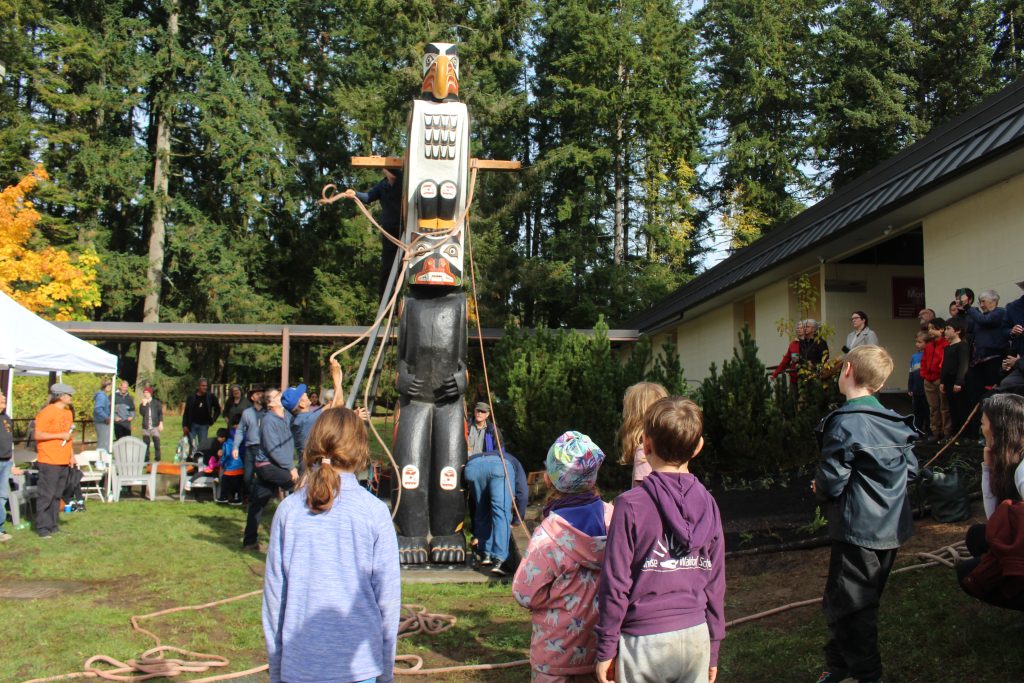
Many children, including students from Sunrise Waldorf School were present at the totem pole raising. Here, children watch as ropes that were used to raise the totem pole are removed. Photo by Shalu Mehta/The Discourse
‘Potlatch mode’
Scow was still hard at work the night before the totem pole was raised to finish it in time. He stayed up until 3 a.m. with the support of his brothers and family, who travelled to Quw’utsun lands from as far as Calgary for the ceremony. Scow said it was a collaborative effort to finish the totem pole right until the end, holding true to what the pole represents — community.
“It’s Potlatch mode, you know. And in our traditional way, somebody will throw a Potlatch and then say something gets broken; the night before — because everything is kept in a treasure box — the night before, somebody will be asked to fix it,” Scow said. “Or sometimes a mask is even carved. You know, maybe four people or five people will carve a mask. So one guy gets started, then he’ll leave and another person will come in and do the next steps. And the final part is the painting. And usually when it goes to the Big House it’s still wet. That’s Potlatch.”
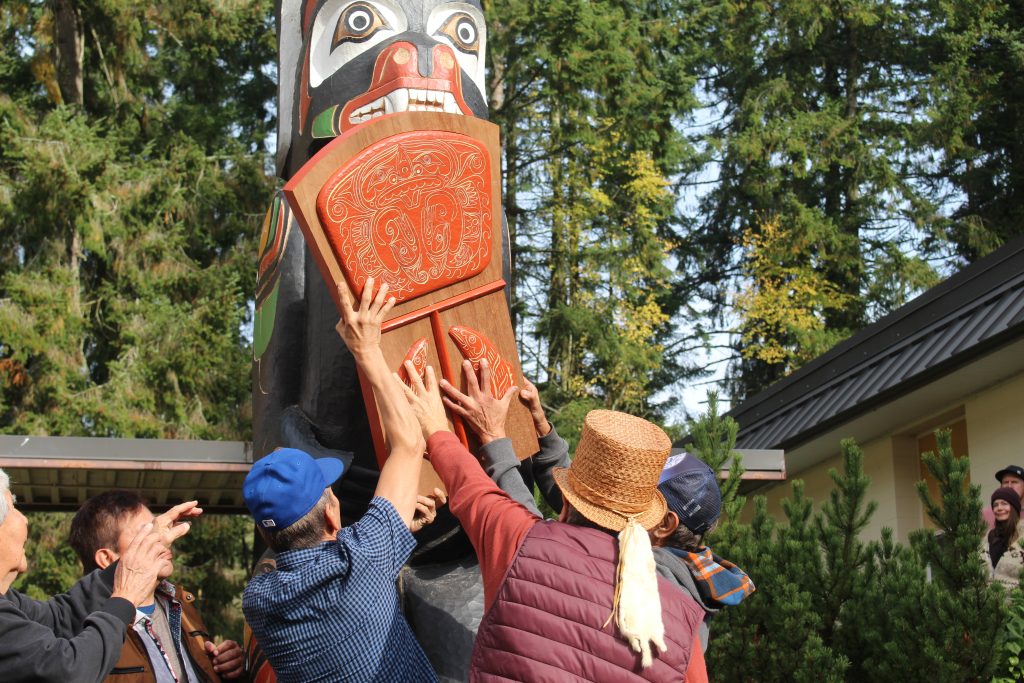
Rupert Scow and his brothers attach the copper shield, carrying his family’s crest, to the totem pole. Photo by Shalu Mehta/The Discourse
The copper shield — the final piece to be added to the totem pole once it was raised — was also the final piece they worked on just hours before the ceremony. It features the Sisiutl (double-headed sea serpent), a family crest from the village of Gwa’yasdams.
The totem pole itself is intricately carved and painted with an eagle at the top followed by a bear. The bear represents Scow’s ancestry as the People of the Bear. The eagle, Scow said, is revered for its close relationship to Creator. It guides people through the physical world and carries their spirits to Creator on its back when they die.
“We used to thank the eagle every time it flew over,” Scow said.
During the raising ceremony, an eagle was seen flying overhead. Scow said his mother was there that day looking down on everyone.
Kwakwa̱ka̱ʼwakw Elder and acclaimed carver Charles Joseph led the totem pole raising ceremony, ensuring it was done in a good way that followed protocol.
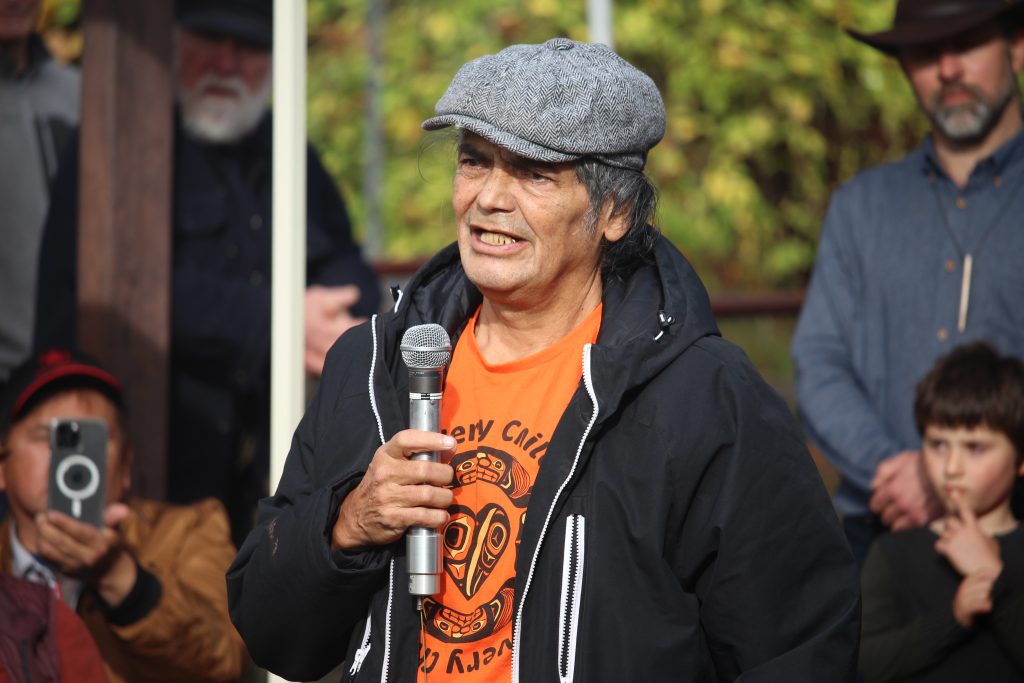 Kwakwa̱ka̱ʼwakw Elder and carver Charles Joseph led the totem pole raising ceremony at the HUB. Photo by Shalu Mehta/The Discourse
Kwakwa̱ka̱ʼwakw Elder and carver Charles Joseph led the totem pole raising ceremony at the HUB. Photo by Shalu Mehta/The Discourse
He began by asking for a moment of silence for the ancestors that taught him and his relations how to create the totem pole and understand stories about what it means to Kwakwa̱ka̱ʼwakw people.
He thanked Cowichan Tribes for allowing this ceremony to take place on Quw’utsun lands and acknowledging who they are as Kwakwa̱ka̱ʼwakw people.
“I guess you would call it reconciliation with the rest of the tribes across Canada and B.C. here because we’re still doing reconciliation and trying to learn more about what that really means,” Joseph said.
Pick love
At the ceremony, Scow said that when he finished carving the totem pole, more than a decade after he first started, he felt an overwhelming sense of community. “My heart swelled,” he said.
“As time went by, it became evident that this was more of a community event because of the people that were dropping by, that I was getting to meet and I was telling my stories to,” Scow said.
So he gifted the pole to the community, and at the ceremony, thanked the many people who have supported him in finishing the totem pole along the way.
As the pole was raised, three ropes were extended into the crowd — one coming from the right of the pole, one coming from the centre and one coming from the left of the pole. Community members all held on to the ropes and pulled to help raise the pole into a standing position.
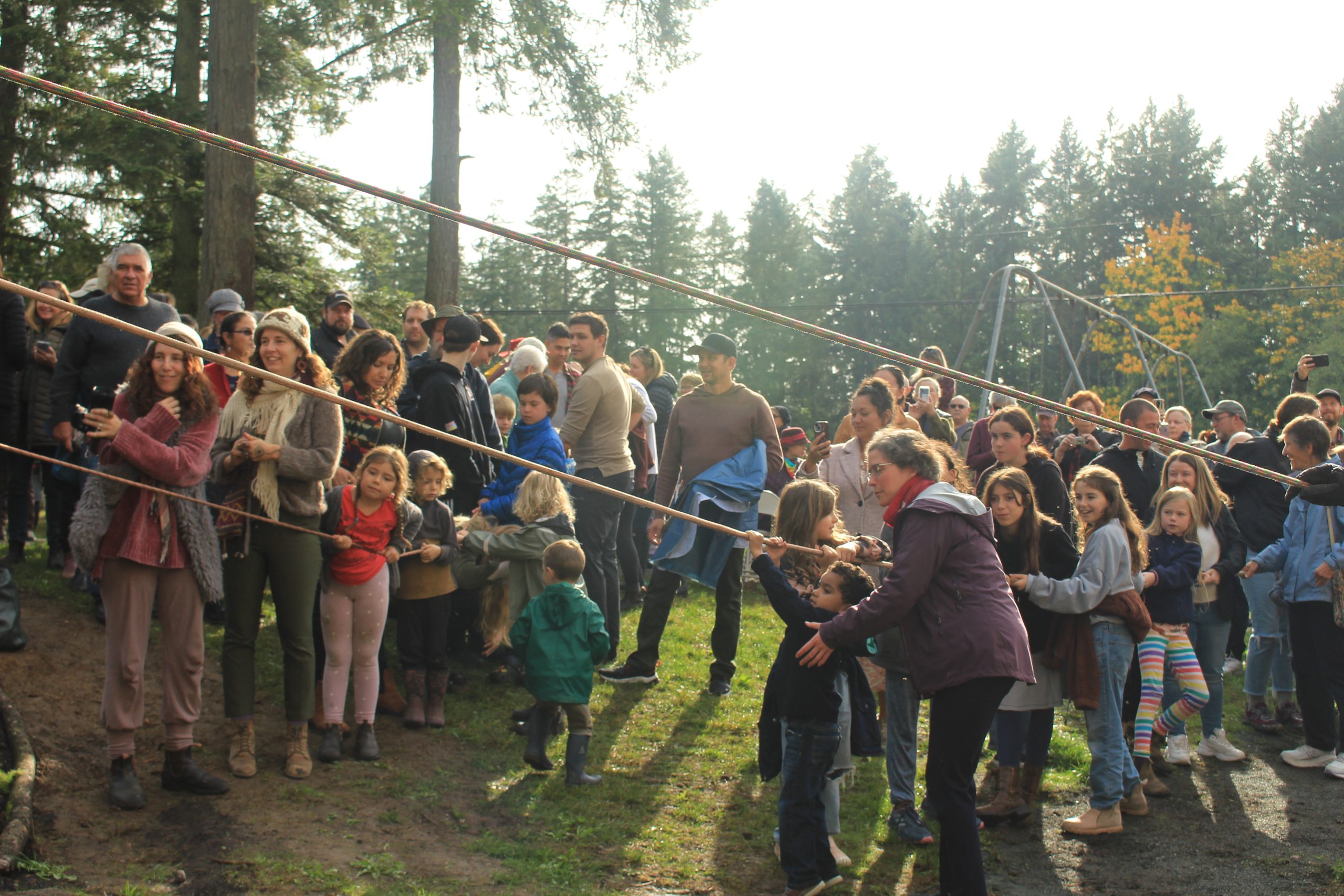
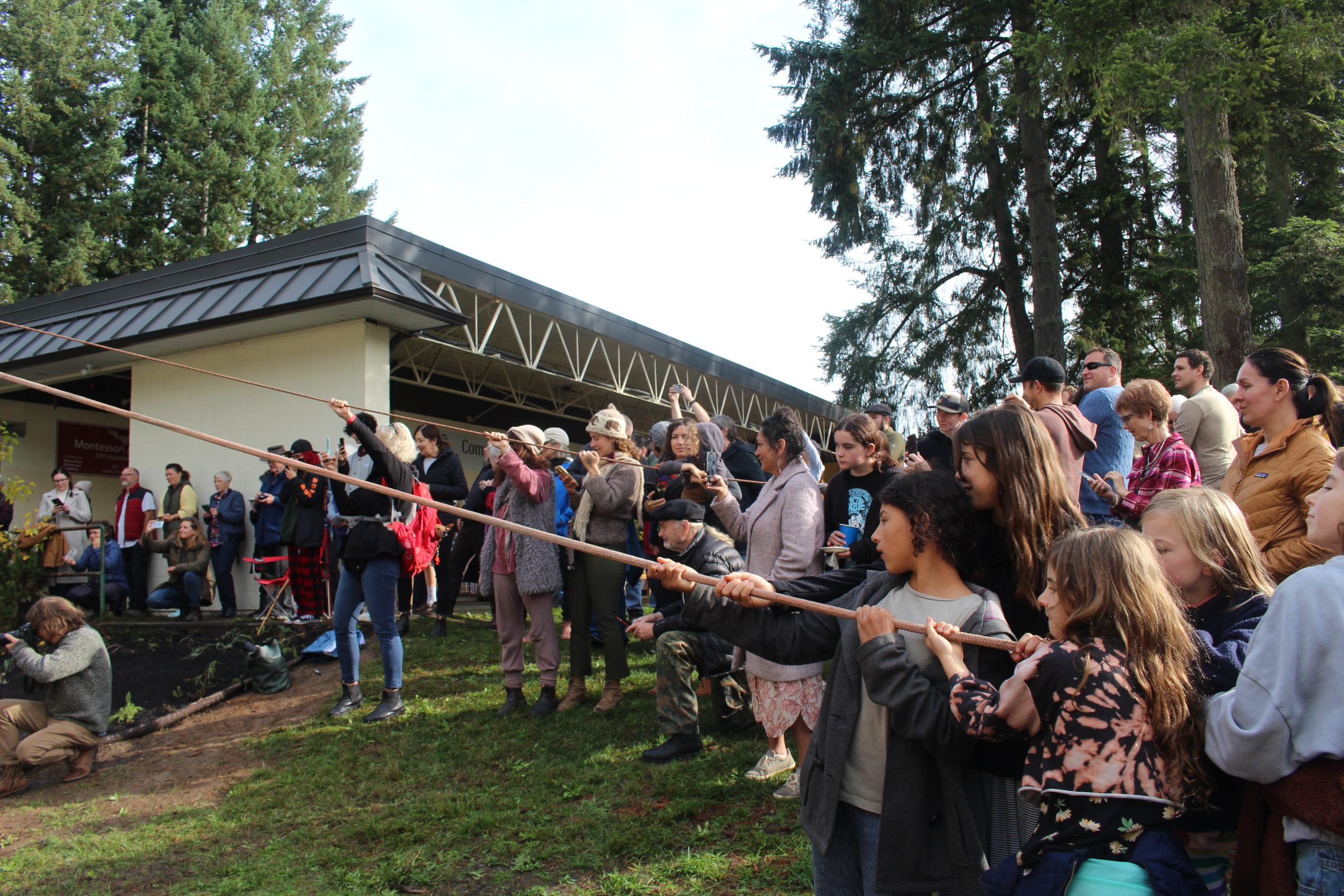
When it was time to raise the totem pole, community members pulled on ropes together to lift it up. Photos by Shalu Mehta/The Discourse
“As we raise this pole, we’re going to hold that connection, cooperation and bringing together of all nations, and we can each look to our neighbour beside us,” said co-carver Lyndon Crossman at the ceremony. “And we’re each going to pull a little bit — we have so many people here — and we have this pole. So I ask that when you grab the rope, because we’re all together, it’s going to feel like nothing.”
The crowd erupted into a cheer when the totem pole was raised and children jumped in excitement to see it standing straight.

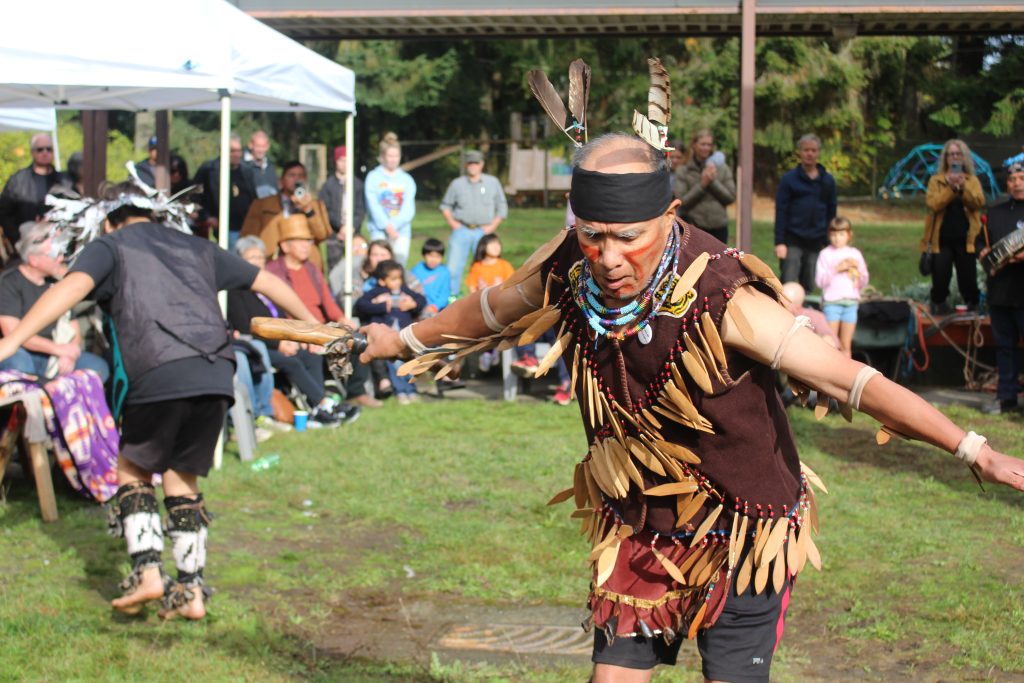
The Quw’utsun Tzinquaw Dancers and Elder Qwiahwultuhw blessed the pole after it was raised. Photos by Shalu Mehta/The Discourse
The Quw’utsun Tzinquaw Dancers also came out to dance and bless the pole. Qwiahwultuhw, who spoke in between performances by the Tzinquaw Dancers, shared that this was a coming together, between tribes and between Indigenous people and settlers.
“It really is a true teaching of unity, the one we’ve been striving for for thousands of years, humanity,” Qwiahwultuhw said. “And especially today with things that are going on in the world and how we can turn that around — we can’t pick sides, the only thing we can pick is love.”
 Discovering the Wisdom of Childhood
Discovering the Wisdom of Childhood Caring for All Stages of Life
Caring for All Stages of Life Bringing Love to Learning for a Lifetime
Bringing Love to Learning for a Lifetime Grade Level Training in Southern California
Grade Level Training in Southern California Full-Time Teacher Education
Full-Time Teacher Education Storytelling Skills for Teachers
Storytelling Skills for Teachers Bay Area Teacher Training
Bay Area Teacher Training Waldorf EC Training & Intensives in Canada
Waldorf EC Training & Intensives in Canada Roadmap to Literacy Books & Courses
Roadmap to Literacy Books & Courses Middle School Science With Roberto Trostli
Middle School Science With Roberto Trostli Art of Teaching Summer Courses 2025
Art of Teaching Summer Courses 2025 Immersive Academics and Arts
Immersive Academics and Arts ~ Ensoul Your World With Color ~
~ Ensoul Your World With Color ~ The Journey is Everything
The Journey is Everything The Art of Administration and Leadership
The Art of Administration and Leadership Apply Today: New Cohort Starts Nov. 2025
Apply Today: New Cohort Starts Nov. 2025 Waldorf-inspired Homeschool Curriculum
Waldorf-inspired Homeschool Curriculum Summer Programs - Culminating Class Trips
Summer Programs - Culminating Class Trips Dancing for All Ages
Dancing for All Ages Jamie York Books, Resources, Workshops
Jamie York Books, Resources, Workshops Quality Education in the Heartland
Quality Education in the Heartland Association for a Healing Education
Association for a Healing Education Transforming Voices Worldwide
Transforming Voices Worldwide Space speaks. Its language is movement.
Space speaks. Its language is movement. Train to Teach in Seattle
Train to Teach in Seattle Flexible preparation for your new grade
Flexible preparation for your new grade Everything a Teacher Needs
Everything a Teacher Needs RSS Feeds
RSS Feeds